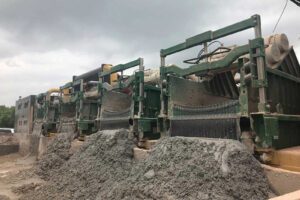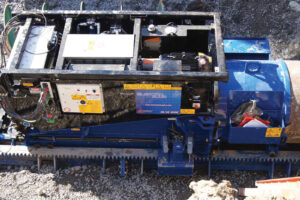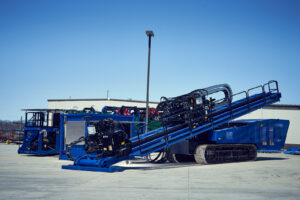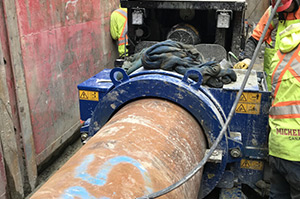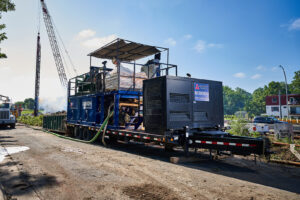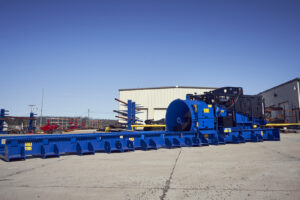BY TOM JACKSON
Whether you are a contractor, OEM, technology company or a government agency handing out the money, it’s a good time to be in the roadbuilding business. “Across many markets, we see a big push for roadbuilding projects as investment and the need for improved infrastructure remains high,” says Frank Dörrie, global product manager road from Volvo Construction Equipment (Volvo CE).
What’s fascinating about this resurgent industry is just how different it is from east to west. In the east China and India are building new roads at a furious pace. In the west, the US and Europe are leveraging new technology to make roadbuilding and transportation infrastructure greener.
“Road networks in many places around the globe are showing visible signs of age. These road infrastructures require structural maintenance and repairs in order to ensure their long-term functional capabilities,” commented a spokesperson from the Wirtgen group.
“Especially in such scenarios, the cold recycling method is a sustainable alternative to conventional construction techniques that addresses and satisfies the world’s urgent needs for road rehabilitation with the necessary speed.”
$1.2 Trillion Infrastructure Bill
In November the US$1.2 trillion Biden Infrastructure bill drew cheers from the industry. Some US$126 billion of that money will go directly the Department of Transportation to use on roadways over the next five years, an increase of about 30%.
Having the funding guaranteed, means that roadbuilding contractors can confidently invest in new equipment knowing that the work to pay for it will be coming – great news for OEMs.
“The passage of the infrastructure bill is a positive step in keeping the US competitive in the world market,” says Kent Godbersen, vice president of worldwide sales and marketing at GOMACO. “We have neglected our most vital assets for far too long and this funding will provide economic benefits immediately and long into the future.”
A big question now is: exactly what does the US do with this money? How much will be dedicated to traditional roadbuilding and how much will go to alternative forms of transportation infrastructure?
The current Secretary of Transportation, Pete Buttigieg, likes passenger rail and has said funding would favour projects that reduce greenhouse gases, increase safety, boost job creation or advance racial equity. The other big trend in the US is that across the country a loose knit but increasingly influential group of transportation professionals are pushing for more investment in multi-modal forms of transportation—the biggest change in US transportation philosophy in more than a half century.
The Biden bill includes the largest-ever federal investment in public transit, allotting US$39 billion to modernise systems, improve access for the elderly and people with disabilities, and repair more than 24,000 buses, 5,000 rail cars and thousands of miles of train tracks. Zero emissions transportation is a priority the Biden infrastructure bill, with US$831 million for EV charging stations, with an aim to have 500,000 EV chargers in place by 2030.
What Technology Is Used In Road Construction?
Designed to help urban planners and government officials, the ATI’s software considers not only the physical attributes of the existing road, but the average vehicle speed on the road, the volume of traffic and economic variables — such as proximity to stores, parks, churches and schools — that might make a multi-modal solution more desirable.
Courchesne is especially keen on electric bikes. “The big cities absolutely have as much potential as the small ones with the electrification of personal mobility, in particular, cities where parking is at a premium and cost of living is high,” he says. “Where there are a lot of young people who can’t afford to own a car and a parking spot, you’re going to see a substantial increase, at least 10%, probably closer to 15% to 20%, in e-mobility.”
The conversion of car lanes to bike lanes is good for car drivers too, says Courchesne. “If you reduce car traffic by just 10%, car drivers benefit with less traffic and more parking. And bike lanes are the cheapest possible investment that a city can make in in their infrastructure,” he says.
Social justice goals are also furthered by multi-modal forms of transportation as many low wage workers spend an inordinate amount of their income on transportation or can’t afford a car to get to work. “The federal government under this current administration has included that as one of the criteria that they’re looking for in cities,” says Courchesne.
Roadbuilding In China
The US still has more highways than any country, but China is catching up fast, having built 160,000km (99,400 miles) since 1988. To support regional economies, China plans to extend the length of its national expressway system by 47% by the year 2035.
When roads of all sizes are included in the total, China’s number is predicted to rise from just over five million km (3.17 million miles) at the end of 2019 to at least six million km (3.7 million miles) in 2035.
China is also hard at work on Belt and Road Initiative which has sixty partner countries spanning three continents and will eventually touch 60% of the world’s population. According to estimates from Morgan Stanley, it will cost China from US$1.2 to US$1.3 trillion.
The transnational nature of the Belt and Road Initiative project should not be underestimated. India’s Prime Minister Narendra Modi recently launched an ambitious 25-year/US$1.3 trillion plan to integrate his country’s infrastructure with China’s Belt and Road Initiative.
In July, the European Parliament adopted the upgraded Connecting Europe Facility program to do the same and allocated €30 billion (US$34 billion) of new funds for transport, digital and energy projects through 2027. Within that, around €23 billion (US$26 billion) is going towards transport projects.
India, like China, is a large country with a big population, however the poor quality, lack of maintenance and small size of India’s roads (75% are only two lane) have failed to deliver the economic benefits that better infrastructure brings. One result of this is that a third of India’s agricultural produce rots in transit.
Still India has the second largest network of roads of all sizes in the world, with a network of over 6.3km (3.9 million miles) of roads. India has boosted road infrastructure spending 17% annually over the last five years and has allocated US$ 1.4 trillion in spending for FY 2019-25.
Public sector spending on roads in the United Kingdom reached nearly £11 billion (US$14.6billion) in 2020/21, an increase of £820 million (US$1.09 billion) when compared to the previous year.
The government is moving forward on a £27 billion (US$35 billion) programme of roadbuilding over the next five years, with plans for a wider infrastructure strategy beyond that date. The plan is considered the largest ever investment in English strategic roads.
Also in England, work is underway by National Highways to execute a Digital Roads 2025 Initiative. According to Nick Harris, chief executive, “We are at the beginning of a digital revolution in roads infrastructure and expect to see more change in the next decade than we have in the last century.” Elements of the plan include digitally enabled design, modular approaches to construction and fabrication and automated construction.
In an interview posted on YouTube, Malcolm Dare, Board and Country level Commercial, Procurement and Supply Chain Director for National Highways spoke at the organization’s recent Net-Zero and innovation event. “If we spend a lot more time in the design, demand and planning phases we will get more efficient when we go on the ground,” says Dare. “We have such a large amount of money from the taxpayer to improve the road network that we also have to catalyze change in the industry for the better.”
Advancements In Technology
There is a considerable amount of research being devoted to building better concrete pavements, says Kevin Klein, president of research and development at GOMACO. The research is being directed to PEM (Performance Engineered Mixtures) for concrete. New testing methods are also being applied for quality control and quality assurance.
The controls on machines that place, consolidate and finish concrete pavements are also improving Klein says. “All of this is coming about because of advancements in the technology being applied across the entire spectrum of our business. Contractors need their employees up to date on these technology trends and they need to strive to build the best pavements they can achieve to remain competitive.”
There is also a lot of talk about technology being imbedded in pavements, but Klein thinks it’s too soon to predict where that is going. “There will certainly be communication technology so that our vehicles can communicate with each other, and likely some type of technology that will charge our EVs as we drive,” he says. “However, I believe the concrete pavement industry will be much better positioned to implement whatever technology can be imbedded into pavements because it will be easier to place the technology transmission devices in concrete as opposed to asphalt.”
The company’s new GP3 Smart Paver was designed to easily accommodate multiple width changes. It has a roller frame with dual telescoping capabilities of up to seven feet (2.13 m) on each side of the paver, for a total of 14 feet (4.26 m) of automatic frame widening.
All pavers are equipped with the latest GOMACO G+ control system along with GRD (GOMACO Remote Diagnostics) which allows the company to communicate with the machine remotely. The GOMACO Navigator software brings all the G+ paver accessories (TBIs, CBIs, GSI, vibration, etc.) together for easy control and allows machines in a paving train to communicate with each other.
Volvo CE is anticipating new solutions for asphalt types, especially for bitumen or bitumen substitutes to process the recycled material, says Dörrie. In Europe there is also emphasis on increased health and safety protection, he says. “As an example, we see an increase in orders for fume extractor systems. There is also understandably a push towards more sustainable technologies as a clear response to the urgent climate crisis.”
Roadbuilding Emissions
As such, the Volvo Group has been validated by the Science-Based Targets Initiative with a goal to reach net-zero value chain greenhouse gas emissions by 2040, says Dörrie. “The design of Volvo CE machines of the coming years will take this into account and factor into account the roughly ten-year life span of our machines.
Horizontal directional drilling may not be a primary roadbuilding application, but in developed areas where existing bridge and highway infrastructure needs rehabilitation, HDD contractors, particularly those who can do large river crossings, are being called upon.
On many older bridges utilities were hung along the side, says Richard Levings, product marketing manager for American Augers. “When these bridges are replaced or rehabilitated, they don’t want them hanging there for a lot of different reasons, so we have several contractors who use our Maxi HDD to reroute the utilities underground or under rivers or large bodies of water in some cases,” he says. Large bore HDD can also be called into use when pipelines are rerouted to make way for new or expanding highway infrastructure, Levings says.
The big advancements in large bore HDD have come in the areas of better controllability through electric-over-hydraulic systems and better displays with more instantaneous feedback, Levings says. “The drills are faster, more efficient and they are easier to set up and tear down. Also, telematics allow us to tap into the diagnostics and make adjustments to the rig anywhere around the globe.”
As mentioned, technology is becoming increasing integrated into road construction. Topcon Positioning systems developed a system called SmoothRide that starts with a LiDAR scan of the entire road surface slated to be overlaid.
The data is processed and converted into a digital model that calculates the difference between the existing pavement and the required design. With Topcon’s Magnet software the digital model can be sent to the milling machine allowing for variable depth milling.
Another new development is Trimble Earthworks Grade Control Platform version 2.4 with support for soil compactors is a GNSS-based, 3D compaction control solution designed to make soil compaction more accurate, faster and easier.
Office-to-field connectivity enables efficient communication and data transfer across the project. Trimble has also introduced the Trimble Roadworks 3D Paving Control Platform for Asphalt Pavers with an automatic 3D screed control system that can improve paving productivity and rideability.




